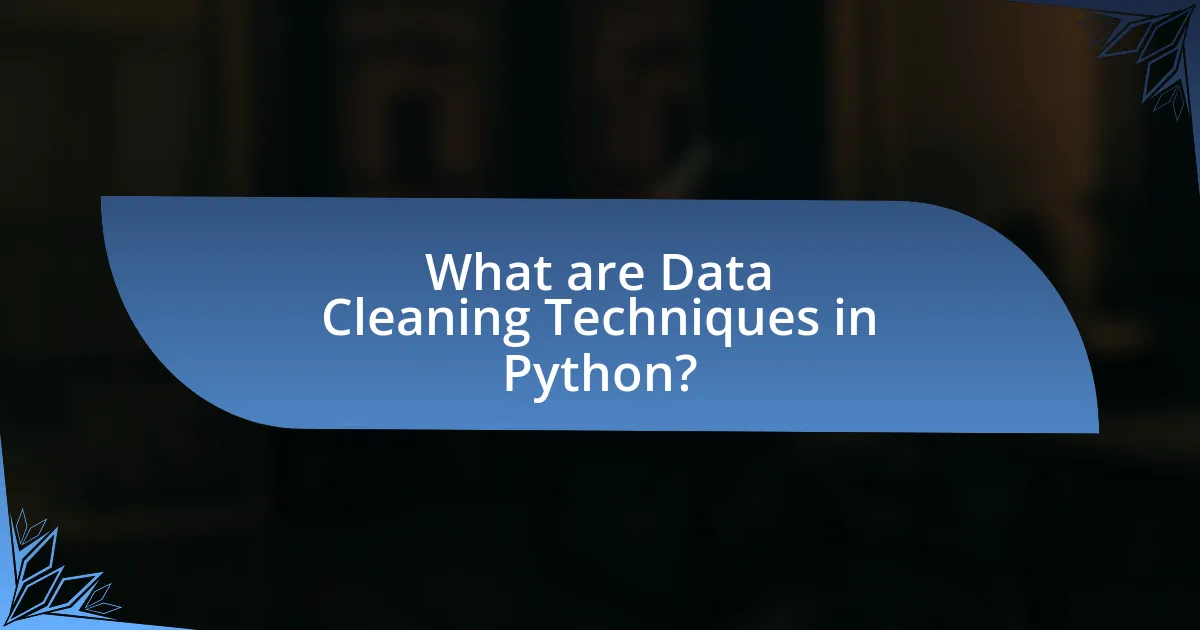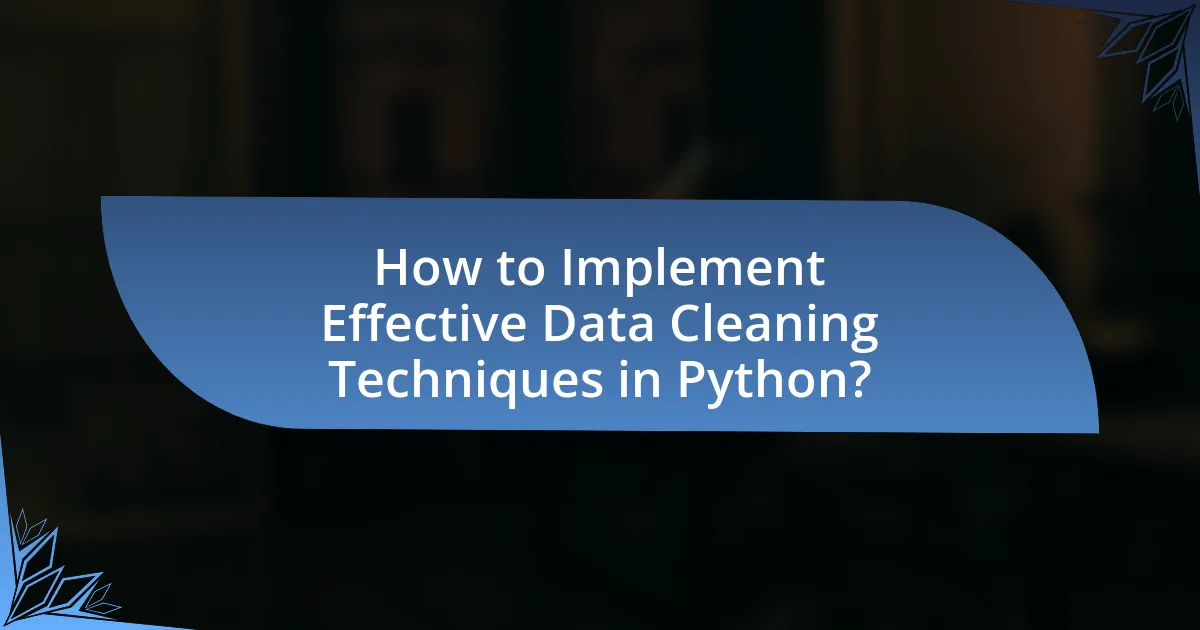Data cleaning techniques in Python are essential for ensuring data quality and integrity, which significantly impacts the accuracy of data analysis and machine learning models. Key methods include handling missing values, removing duplicates, correcting data types, and standardizing data formats, primarily utilizing libraries such as Pandas and NumPy. The article emphasizes the importance of data cleaning in preventing misleading conclusions and highlights best practices, common pitfalls, and automation strategies to enhance efficiency. Additionally, it discusses the role of documentation and version control in maintaining data integrity throughout the cleaning process.

What are Data Cleaning Techniques in Python?
Data cleaning techniques in Python include methods such as handling missing values, removing duplicates, correcting data types, and standardizing data formats. These techniques are essential for ensuring data quality and integrity, which directly impacts the accuracy of data analysis and machine learning models. For instance, the Pandas library provides functions like dropna() for removing missing values and fillna() for imputing them, while drop_duplicates() helps eliminate duplicate entries. Additionally, converting data types can be achieved using astype(), and standardization can be performed through string manipulation functions. These practices are widely recognized in data science for enhancing dataset reliability and usability.
Why is Data Cleaning Important in Data Analysis?
Data cleaning is crucial in data analysis because it ensures the accuracy and reliability of the insights derived from the data. Clean data eliminates errors, inconsistencies, and inaccuracies that can lead to misleading conclusions. For instance, a study by IBM found that poor data quality costs organizations an average of $15 million per year, highlighting the financial impact of unclean data. By implementing data cleaning techniques, analysts can improve the quality of their datasets, leading to more informed decision-making and better outcomes.
What are the consequences of not cleaning data?
Not cleaning data leads to inaccurate analyses and poor decision-making. When data is unclean, it may contain duplicates, errors, or inconsistencies, which can skew results and misinform stakeholders. For instance, a study by IBM found that poor data quality costs organizations an average of $15 million per year. Additionally, unclean data can result in wasted resources, as teams may spend excessive time trying to interpret flawed information. Ultimately, the lack of data cleaning undermines the reliability of insights derived from data, impacting overall business performance.
How does data quality impact analysis outcomes?
Data quality significantly impacts analysis outcomes by determining the accuracy and reliability of the results derived from data analysis. High-quality data leads to valid insights, while poor data quality can result in misleading conclusions and ineffective decision-making. For instance, a study by Redman (1998) in “Data Quality: The Field Guide” highlights that organizations lose approximately 20% to 30% of their revenue due to poor data quality, underscoring the financial implications of inaccurate data. Thus, ensuring data quality is essential for achieving meaningful and actionable analysis outcomes.
What are the Common Data Cleaning Techniques in Python?
Common data cleaning techniques in Python include handling missing values, removing duplicates, correcting data types, and standardizing data formats. Handling missing values can be achieved using methods like imputation or deletion, which ensures that analyses are not skewed by incomplete data. Removing duplicates is essential for maintaining data integrity, and this can be done using the drop_duplicates() function in pandas. Correcting data types ensures that numerical data is not mistakenly treated as strings, which can be accomplished with the astype() method. Standardizing data formats, such as date formats or categorical variables, helps in maintaining consistency across datasets. These techniques are widely supported by libraries like pandas and NumPy, which are commonly used in Python for data manipulation and cleaning tasks.
How can missing values be handled effectively?
Missing values can be handled effectively through techniques such as imputation, deletion, and using algorithms that support missing values. Imputation involves replacing missing values with substituted values, such as the mean, median, or mode of the dataset, which helps maintain the dataset’s size and integrity. Deletion entails removing records with missing values, which can be effective when the missing data is minimal and does not significantly impact the analysis. Additionally, certain machine learning algorithms, like decision trees, can handle missing values inherently without requiring imputation or deletion. These methods are supported by statistical practices that emphasize the importance of maintaining data quality for accurate analysis and modeling.
What methods are used for detecting and removing duplicates?
Methods for detecting and removing duplicates include using algorithms such as hashing, which generates a unique identifier for each record, and comparing these identifiers to identify duplicates. Additionally, data manipulation libraries in Python, such as Pandas, provide built-in functions like drop_duplicates() that efficiently remove duplicate entries from datasets. These methods are validated by their widespread use in data preprocessing tasks, ensuring data integrity and accuracy in analyses.
What Libraries in Python are Used for Data Cleaning?
Pandas and NumPy are the primary libraries in Python used for data cleaning. Pandas provides data structures like DataFrames that facilitate data manipulation and cleaning tasks, such as handling missing values, filtering data, and merging datasets. NumPy offers support for numerical operations and array manipulation, which is essential for cleaning numerical data efficiently. Both libraries are widely adopted in the data science community, with Pandas being particularly noted for its user-friendly interface and extensive functionality for data wrangling.
How does Pandas facilitate data cleaning tasks?
Pandas facilitates data cleaning tasks by providing a comprehensive set of tools for data manipulation and analysis. It allows users to easily handle missing data through functions like dropna() and fillna(), which enable the removal or imputation of null values. Additionally, Pandas supports data type conversions with methods such as astype(), ensuring that data is in the correct format for analysis. The library also offers powerful filtering capabilities, allowing users to identify and remove duplicates using drop_duplicates(). Furthermore, Pandas enables string manipulation and regular expression operations through its str accessor, which aids in standardizing text data. These features collectively streamline the data cleaning process, making it efficient and effective for users.
What role does NumPy play in data cleaning processes?
NumPy plays a crucial role in data cleaning processes by providing efficient data manipulation and numerical operations. It enables users to handle large datasets with ease, allowing for operations such as filtering, reshaping, and handling missing values. For instance, NumPy’s array structure allows for fast computations and memory efficiency, which is essential when cleaning data. Additionally, functions like numpy.isnan() help identify and manage NaN values, while numpy.where() can be used to replace or filter out unwanted data points. These capabilities make NumPy an indispensable tool for data cleaning in Python, ensuring that datasets are accurate and ready for analysis.
How can Data Cleaning Techniques be Automated in Python?
Data cleaning techniques can be automated in Python using libraries such as Pandas, NumPy, and Scikit-learn. These libraries provide functions for handling missing values, removing duplicates, and transforming data types, which streamline the data cleaning process. For instance, Pandas offers methods like dropna() to remove missing values and fillna() to replace them, while drop_duplicates() can eliminate duplicate entries. Additionally, Scikit-learn’s ColumnTransformer allows for the application of different preprocessing techniques to specific columns, facilitating automation in data transformation tasks. This automation enhances efficiency and accuracy in data preparation, which is critical for effective data analysis and modeling.
What are the benefits of automating data cleaning?
Automating data cleaning significantly enhances efficiency and accuracy in data processing. By utilizing automated tools, organizations can reduce the time spent on manual data entry and correction, which often leads to human errors. For instance, studies show that automated data cleaning can decrease processing time by up to 80%, allowing data analysts to focus on more strategic tasks. Additionally, automation ensures consistency in data formatting and validation, which is crucial for maintaining data integrity across large datasets. This consistency minimizes discrepancies that can arise from manual interventions, thereby improving the overall quality of the data used for analysis and decision-making.
How can scripts be created for repetitive cleaning tasks?
Scripts for repetitive cleaning tasks can be created using programming languages like Python, which offers libraries such as Pandas and NumPy specifically designed for data manipulation. By defining functions that encapsulate the cleaning operations—such as removing duplicates, handling missing values, and standardizing formats—users can automate these tasks efficiently. For instance, a script can be written to read a dataset, apply the defined cleaning functions, and output the cleaned data, significantly reducing manual effort and minimizing errors. This approach is validated by the widespread use of Python in data science, where automation of data cleaning is essential for maintaining data integrity and improving workflow efficiency.

What Best Practices Should be Followed for Data Cleaning in Python?
Best practices for data cleaning in Python include using libraries like Pandas for efficient data manipulation, ensuring data types are correctly assigned, handling missing values appropriately, and removing duplicates. Utilizing Pandas allows for streamlined operations on data frames, which is essential for effective cleaning. Correctly assigning data types, such as converting strings to datetime objects, enhances data integrity and analysis accuracy. Handling missing values can involve techniques like imputation or removal, depending on the context, which is crucial for maintaining dataset quality. Removing duplicates ensures that analyses are based on unique records, preventing skewed results. These practices are supported by the widespread use of Pandas in data science, as it provides robust functions for these tasks, making it a standard tool in the industry.
How can one ensure consistency in data cleaning?
To ensure consistency in data cleaning, one should establish a standardized data cleaning process that includes predefined rules and guidelines. This process should involve using consistent methods for handling missing values, outliers, and data formatting across all datasets. For example, employing libraries like Pandas in Python allows for the implementation of uniform functions to address these issues, ensuring that similar data is treated in the same manner. Additionally, maintaining thorough documentation of the cleaning procedures and regularly reviewing the data cleaning practices can help identify discrepancies and reinforce consistency.
What are the key steps to maintain data integrity during cleaning?
To maintain data integrity during cleaning, it is essential to follow systematic steps that ensure accuracy and consistency. First, establish a clear understanding of the data structure and requirements, which allows for targeted cleaning efforts. Next, implement validation checks to identify and rectify errors, such as duplicates or inconsistencies, ensuring that the data remains reliable. Additionally, maintain a backup of the original dataset before any cleaning operations, which safeguards against accidental data loss. Finally, document all cleaning processes and changes made, providing a transparent trail that can be reviewed for accuracy and compliance. These steps collectively reinforce data integrity by ensuring that the cleaned data accurately reflects the original dataset’s intent and quality.
How can documentation improve the data cleaning process?
Documentation can significantly improve the data cleaning process by providing clear guidelines and standards for data handling. When documentation outlines specific procedures, it ensures consistency in data cleaning practices, which reduces errors and enhances data quality. For instance, a study by the Data Management Association highlights that organizations with well-documented data processes experience a 30% reduction in data-related errors. This consistency allows team members to understand the rationale behind data cleaning decisions, facilitating better collaboration and knowledge transfer. Furthermore, comprehensive documentation serves as a reference point for future data cleaning efforts, enabling teams to replicate successful strategies and avoid past mistakes.
What are the Common Pitfalls in Data Cleaning?
Common pitfalls in data cleaning include overlooking missing values, failing to standardize data formats, and not validating data accuracy. Overlooking missing values can lead to biased analyses, as studies show that up to 30% of datasets may contain missing entries. Failing to standardize formats, such as date and currency, can result in inconsistencies that complicate data processing. Additionally, not validating data accuracy can introduce errors; research indicates that data quality issues can cost organizations up to 20% of their revenue. These pitfalls highlight the importance of thorough and systematic data cleaning practices.
What mistakes should be avoided during data cleaning?
During data cleaning, mistakes to avoid include failing to document changes, which can lead to confusion and loss of data integrity. Not validating data types can result in errors during analysis, as incorrect types may cause processing issues. Ignoring duplicates can skew results, as they may lead to overestimation of trends or patterns. Additionally, neglecting to handle missing values appropriately can introduce bias, as simply removing them may discard valuable information. Lastly, not standardizing formats can create inconsistencies, making it difficult to analyze data effectively. These mistakes can significantly impact the quality and reliability of the cleaned data.
How can one identify and rectify errors in the cleaning process?
To identify and rectify errors in the cleaning process, one should implement systematic validation techniques such as data profiling and consistency checks. Data profiling involves analyzing the dataset to uncover anomalies, missing values, and outliers, which can indicate errors. Consistency checks ensure that data adheres to predefined rules and formats, highlighting discrepancies that need correction. For instance, using Python libraries like Pandas, one can apply functions such as isnull() to detect missing values and describe() to summarize data distributions, revealing potential issues. By addressing these identified errors through methods like imputation for missing values or normalization for outliers, the overall quality of the dataset can be significantly improved.
What Tools and Resources are Available for Data Cleaning in Python?
Python offers several tools and resources for data cleaning, including libraries such as Pandas, NumPy, and OpenRefine. Pandas is widely used for data manipulation and analysis, providing functions for handling missing data, filtering, and transforming datasets. NumPy complements Pandas by offering support for numerical operations and array manipulation, which is essential for cleaning numerical data. OpenRefine, although not a Python library, is a powerful tool for working with messy data, allowing users to explore, clean, and transform data sets efficiently. These tools are supported by extensive documentation and community resources, making them accessible for users at all skill levels.
What online resources can help improve data cleaning skills?
Online resources that can help improve data cleaning skills include Coursera, DataCamp, and Kaggle. Coursera offers courses like “Data Cleaning” by Johns Hopkins University, which covers essential techniques and tools for effective data cleaning. DataCamp provides interactive tutorials specifically focused on data manipulation and cleaning in Python, such as “Cleaning Data in Python.” Kaggle features datasets and community-driven notebooks that demonstrate practical data cleaning techniques, allowing users to learn from real-world examples. These platforms collectively offer structured learning paths, hands-on practice, and community support, making them valuable for enhancing data cleaning skills.
How can community forums assist in troubleshooting data cleaning issues?
Community forums assist in troubleshooting data cleaning issues by providing a platform for users to share experiences, solutions, and best practices. These forums enable individuals facing similar data cleaning challenges to ask questions and receive guidance from more experienced members, fostering a collaborative environment. For instance, users can post specific problems related to data inconsistencies or formatting errors and receive targeted advice, code snippets, or references to relevant libraries in Python, such as Pandas or NumPy. The collective knowledge and diverse perspectives found in these forums can lead to quicker resolutions and innovative approaches to common data cleaning tasks.

How to Implement Effective Data Cleaning Techniques in Python?
To implement effective data cleaning techniques in Python, utilize libraries such as Pandas and NumPy for data manipulation and cleaning tasks. Pandas provides functions like dropna() to remove missing values, fillna() to replace them, and astype() to convert data types, ensuring data consistency. For outlier detection, methods like Z-score or IQR can be applied using NumPy, allowing for the identification and removal of anomalous data points. Additionally, regular expressions can be employed for string cleaning, such as removing unwanted characters or formatting inconsistencies. These techniques are validated by their widespread use in data science projects, demonstrating their effectiveness in preparing datasets for analysis.
What are the steps to create a data cleaning workflow?
To create a data cleaning workflow, follow these steps: First, define the objectives of the data cleaning process, which involves identifying the specific issues that need to be addressed, such as missing values, duplicates, or inconsistencies. Next, collect and import the data into a suitable environment, typically using libraries like Pandas in Python for efficient handling. After importing, perform an initial assessment of the data to understand its structure and quality, which can include generating summary statistics and visualizations.
Subsequently, clean the data by addressing the identified issues: handle missing values through imputation or removal, eliminate duplicates, and standardize formats for consistency. Following the cleaning process, validate the data to ensure that the cleaning steps have been effective and that the data meets the required quality standards. Finally, document the workflow and the decisions made during the cleaning process for future reference and reproducibility. This structured approach ensures a systematic and effective data cleaning workflow.
How can one prioritize cleaning tasks based on data quality?
To prioritize cleaning tasks based on data quality, one should assess the impact of data issues on analysis outcomes. Identifying critical data elements that directly affect decision-making allows for focused cleaning efforts. For instance, if missing values in key variables lead to significant bias in results, addressing these gaps should take precedence. Additionally, employing metrics such as data completeness, accuracy, and consistency can help rank tasks; for example, a dataset with 30% missing values in a crucial column should be prioritized over one with minor formatting errors. This approach ensures that the most detrimental data quality issues are resolved first, enhancing overall data integrity and usability.
What tools can be integrated into a data cleaning workflow?
Tools that can be integrated into a data cleaning workflow include Pandas, NumPy, OpenRefine, and Dask. Pandas is widely used for data manipulation and analysis, providing functions for handling missing data and filtering datasets. NumPy offers support for numerical operations, which can assist in cleaning numerical data. OpenRefine is a powerful tool for exploring and cleaning messy data, allowing users to transform data formats and detect inconsistencies. Dask enables parallel computing, making it suitable for handling large datasets efficiently during the cleaning process. These tools collectively enhance the efficiency and effectiveness of data cleaning tasks in Python.
What are the Tips for Successful Data Cleaning in Python?
Successful data cleaning in Python involves several key practices: first, always start by understanding your data’s structure and content through exploratory data analysis (EDA). This helps identify missing values, outliers, and inconsistencies. Second, utilize libraries like Pandas for efficient data manipulation, as it provides functions for handling missing data, such as fillna() and dropna(). Third, ensure data types are correctly assigned using astype() to avoid errors in analysis. Fourth, standardize data formats, especially for categorical variables, to maintain consistency. Lastly, document your cleaning process to ensure reproducibility and clarity. These practices are supported by the widespread use of Pandas in data science, which has become a standard tool for data cleaning tasks.
How can one leverage version control for data cleaning scripts?
One can leverage version control for data cleaning scripts by using systems like Git to track changes, collaborate with others, and maintain a history of modifications. This allows data scientists to revert to previous versions if errors are introduced during the cleaning process, ensuring data integrity. Additionally, version control facilitates collaboration by enabling multiple contributors to work on different aspects of the scripts simultaneously, merging their changes seamlessly. The ability to document changes through commit messages also enhances transparency and understanding of the evolution of the data cleaning process.
What are the best practices for testing cleaned data?
The best practices for testing cleaned data include validating data integrity, ensuring consistency, and performing statistical analysis. Validating data integrity involves checking for missing values, duplicates, and outliers to confirm that the data meets predefined quality standards. Ensuring consistency requires cross-referencing cleaned data against original datasets or established benchmarks to verify accuracy. Performing statistical analysis, such as calculating means, medians, and standard deviations, helps identify anomalies and assess the overall distribution of the data. These practices are essential for maintaining high-quality datasets, as evidenced by studies showing that data quality directly impacts analytical outcomes and decision-making processes.


